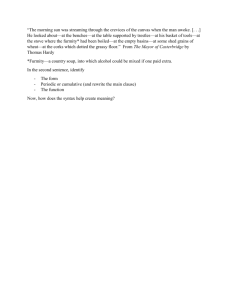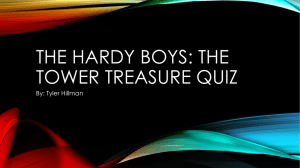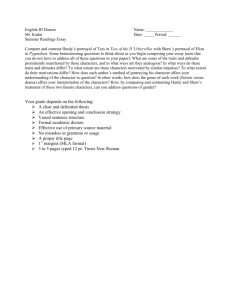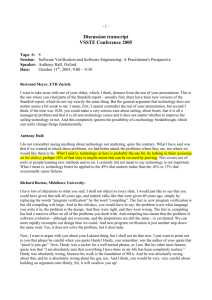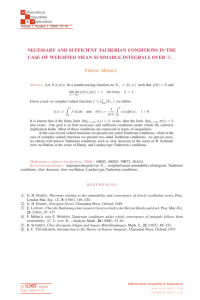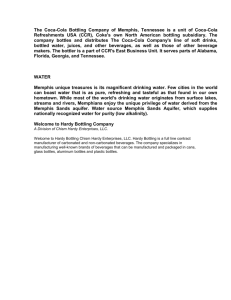The Mayor of Casterbridge | Individual and Icon
advertisement
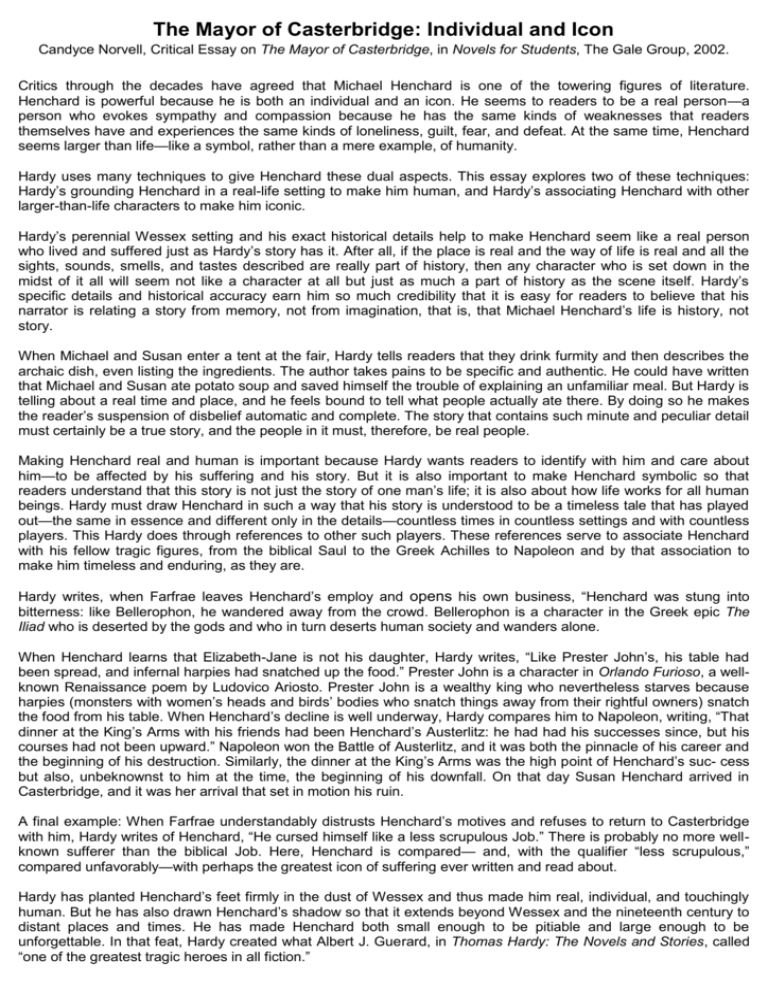
The Mayor of Casterbridge: Individual and Icon Candyce Norvell, Critical Essay on The Mayor of Casterbridge, in Novels for Students, The Gale Group, 2002. Critics through the decades have agreed that Michael Henchard is one of the towering figures of literature. Henchard is powerful because he is both an individual and an icon. He seems to readers to be a real person—a person who evokes sympathy and compassion because he has the same kinds of weaknesses that readers themselves have and experiences the same kinds of loneliness, guilt, fear, and defeat. At the same time, Henchard seems larger than life—like a symbol, rather than a mere example, of humanity. Hardy uses many techniques to give Henchard these dual aspects. This essay explores two of these techniques: Hardy’s grounding Henchard in a real-life setting to make him human, and Hardy’s associating Henchard with other larger-than-life characters to make him iconic. Hardy’s perennial Wessex setting and his exact historical details help to make Henchard seem like a real person who lived and suffered just as Hardy’s story has it. After all, if the place is real and the way of life is real and all the sights, sounds, smells, and tastes described are really part of history, then any character who is set down in the midst of it all will seem not like a character at all but just as much a part of history as the scene itself. Hardy’s specific details and historical accuracy earn him so much credibility that it is easy for readers to believe that his narrator is relating a story from memory, not from imagination, that is, that Michael Henchard’s life is history, not story. When Michael and Susan enter a tent at the fair, Hardy tells readers that they drink furmity and then describes the archaic dish, even listing the ingredients. The author takes pains to be specific and authentic. He could have written that Michael and Susan ate potato soup and saved himself the trouble of explaining an unfamiliar meal. But Hardy is telling about a real time and place, and he feels bound to tell what people actually ate there. By doing so he makes the reader’s suspension of disbelief automatic and complete. The story that contains such minute and peculiar detail must certainly be a true story, and the people in it must, therefore, be real people. Making Henchard real and human is important because Hardy wants readers to identify with him and care about him—to be affected by his suffering and his story. But it is also important to make Henchard symbolic so that readers understand that this story is not just the story of one man’s life; it is also about how life works for all human beings. Hardy must draw Henchard in such a way that his story is understood to be a timeless tale that has played out—the same in essence and different only in the details—countless times in countless settings and with countless players. This Hardy does through references to other such players. These references serve to associate Henchard with his fellow tragic figures, from the biblical Saul to the Greek Achilles to Napoleon and by that association to make him timeless and enduring, as they are. Hardy writes, when Farfrae leaves Henchard’s employ and opens his own business, “Henchard was stung into bitterness: like Bellerophon, he wandered away from the crowd. Bellerophon is a character in the Greek epic The Iliad who is deserted by the gods and who in turn deserts human society and wanders alone. When Henchard learns that Elizabeth-Jane is not his daughter, Hardy writes, “Like Prester John’s, his table had been spread, and infernal harpies had snatched up the food.” Prester John is a character in Orlando Furioso, a wellknown Renaissance poem by Ludovico Ariosto. Prester John is a wealthy king who nevertheless starves because harpies (monsters with women’s heads and birds’ bodies who snatch things away from their rightful owners) snatch the food from his table. When Henchard’s decline is well underway, Hardy compares him to Napoleon, writing, “That dinner at the King’s Arms with his friends had been Henchard’s Austerlitz: he had had his successes since, but his courses had not been upward.” Napoleon won the Battle of Austerlitz, and it was both the pinnacle of his career and the beginning of his destruction. Similarly, the dinner at the King’s Arms was the high point of Henchard’s suc- cess but also, unbeknownst to him at the time, the beginning of his downfall. On that day Susan Henchard arrived in Casterbridge, and it was her arrival that set in motion his ruin. A final example: When Farfrae understandably distrusts Henchard’s motives and refuses to return to Casterbridge with him, Hardy writes of Henchard, “He cursed himself like a less scrupulous Job.” There is probably no more wellknown sufferer than the biblical Job. Here, Henchard is compared— and, with the qualifier “less scrupulous,” compared unfavorably—with perhaps the greatest icon of suffering ever written and read about. Hardy has planted Henchard’s feet firmly in the dust of Wessex and thus made him real, individual, and touchingly human. But he has also drawn Henchard’s shadow so that it extends beyond Wessex and the nineteenth century to distant places and times. He has made Henchard both small enough to be pitiable and large enough to be unforgettable. In that feat, Hardy created what Albert J. Guerard, in Thomas Hardy: The Novels and Stories, called “one of the greatest tragic heroes in all fiction.” Individual and Icon: Questions 1. Explain what Norvell means by the terms ‘individual’ and ‘icon’. 2. What methods does she identify that Hardy employs to convey Henchard in this way? Provide some specific detail of these. 3. What is the intended effect of Hardy’s presentation, on the reader, of Henchard as an ‘individual’? 4. How does Hardy broaden our reading of Henchard then and make him iconic? Why does he do this? 5. Explain the allusions to Bellerophon, Prester John and Napoleon comment on their appropriateness. 6. Explain the metaphor used in the last paragraph, ‘drawn Henchard’s shadow’. 7. Why does Guerard assert Henchard is ‘one of the greatest tragic heroes of all fiction’? Homework: Find and quote the allusions to Saul, Job, Achilles and Faust (and any others you can find) and comment on their value to the characterisation of Henchard. Close Reading Questions: Individual and Icon 1. Where does, Novell assert, Henchard get his ‘power’ from, that which makes him ‘one of the towering figures of literature’? 2. What two elements, does Novell suggest, enable Hardy to imbue Henchard with this duality? 3. How does Hardy make Henchard seem like an historical figure? 4. What is Hardy’s goal in presenting Henchard as a very ‘human’ character? 5. What primary method does Hardy employ to elevate Henchard to iconic or symbolic status? 6. List all the figures from literature and myth alluded to that are mentioned in the article. 7. What strikes you as unusual about the last of the examples cited? 8. What language feature is the expression ‘planted . . . firmly in the dust of Wessex? 9. In your own words,
